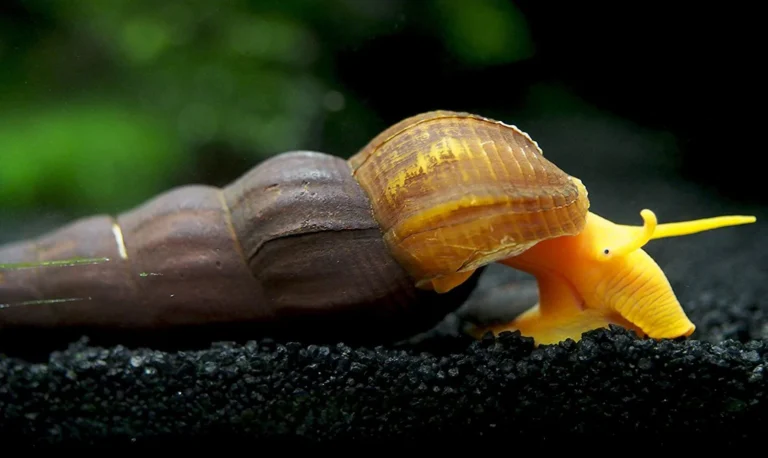When I first saw a Rabbit Snail, I was struck by its beauty. Its subtle grace and vivid colors brought life to my aquarium. These creatures come from the clear lakes of Sulawesi, Indonesia. They have found a special place not only in tanks across America but also in the hearts of those who love them.
Rabbit Snails began arriving in our homes around 2008, thanks to the aquarium trade. The Orange Poso, a member of the Pachychilidae family, is especially popular. It’s known for its bright color and friendly nature. The more I discovered about rabbit snails, the more fascinated I became. They can grow a few inches to 4 inches long.
To create the right tank setup, keep the water warm, between 76 and 84 degrees. This mimics their tropical home. Pay attention to the water’s pH and hardness, too. This will keep their shells strong and shiny.
Rabbit snails can live up to three years. They show us the beauty of life and teach us to value the present. They move slowly, searching for algae and detritus to eat. This helps keep the tank clean and balanced.
Taking care of Rabbit Snails means appreciating every part of them. From the shape of their shells to their need for peaceful tank conditions. As I learned to care for these snails, I found their quiet beauty and unique size make every moment special.
Introducing Rabbit Snails

Welcome to the world of Rabbit Snails, a special kind of freshwater snail. They’ve been part of the hobbyist scene since 2007. They come from the clear, warm waters of Sulawesi lakes. These snails add beauty and calm to any fish tank with their unique shells and slow movements.
A Glimpse into the Unique World of Rabbit Snails
I’m fascinated by Rabbit Snails, also known as Tylomelania. They hail from Sulawesi lakes in Indonesia. Not only are they beautiful with a variety of colors like Orange Poso, Golden, Chocolate, and Yellow, but they also play a key role in their ecosystem.
Understanding the Exotic Appearance and Habitat
Rabbit Snails do best in settings similar to their home in the Sulawesi lakes. This means warm, alkaline water with plenty of ground to roam. They have tall, spiraled shells that catch the eye. Their friendly nature makes them a great choice for tanks with other peaceful fish.
The Historical Popularity of Rabbit Snails in Aquascaping
Rabbit Snails have been a favorite in aquascaping since 2008. They are peaceful and look unique, perfect for a planted tank. They eat algae and detritus, helping keep the water clean.
It’s important to know how to take care of Rabbit Snails if you want them in your tank. They not only make your tank more beautiful but also have interesting behaviors. They are a great choice for both new and experienced aquarium owners.
Rabbit Snail Care Guide
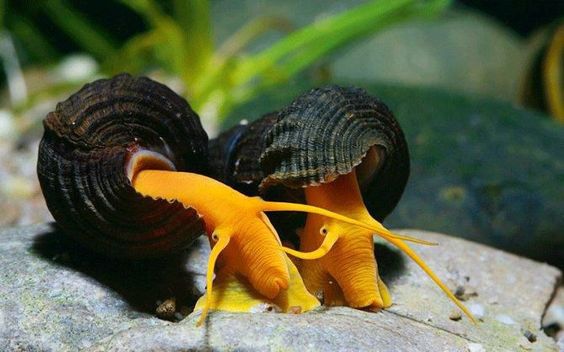
Welcome to the ultimate care guide for rabbit snails. This guide is perfect for any freshwater aquarist looking to add some intrigue to their tank with the Tylomelania genus. Here, we will cover everything needed to keep your rabbit snail healthy, including effective algae control and essential breeding tips.
Understanding the basic needs of rabbit snails is essential. They love tropical settings. A precise setup is key, with a recommended 30 gallons of water for enough space.
Rabbit snails need warmer waters, ideally between 72°F and 75°F. Stable water quality is crucial, aiming for a pH level of 7.0 to 8.5. Also, maintain a general hardness (GH) of 4 to 12 dGH to keep their shells strong.
A balanced diet is vital for rabbit snails. They love algae but need more. Ensure you provide calcium-rich supplements for shell strength and vegetable matter for their overall diet.
Here’s a quick reference for the best conditions to keep your rabbit snails thriving:
Criteria |
Optimal Range |
|---|---|
Temperature |
72°F – 75°F |
pH Level |
7.0 – 8.5 |
General Hardness (GH) |
4 – 12 dGH |
Tank Size |
Minimum 30 gallons |
Diet |
Algae, vegetable matter, calcium supplements |
Rabbit snails breed slowly, a plus for those worried about overpopulation. They produce one or two babies per cycle.
One special thing about rabbit snails is their calm nature. Ensure their safety by checking tank equipment and conditions. Regular checks and avoiding copper treatments will keep them well.
With this guide, you’re set for a rewarding journey with rabbit snails. You’ll add variety to your aquarium and learn a lot about these amazing creatures.
Setting Up Your Rabbit Snail Tank
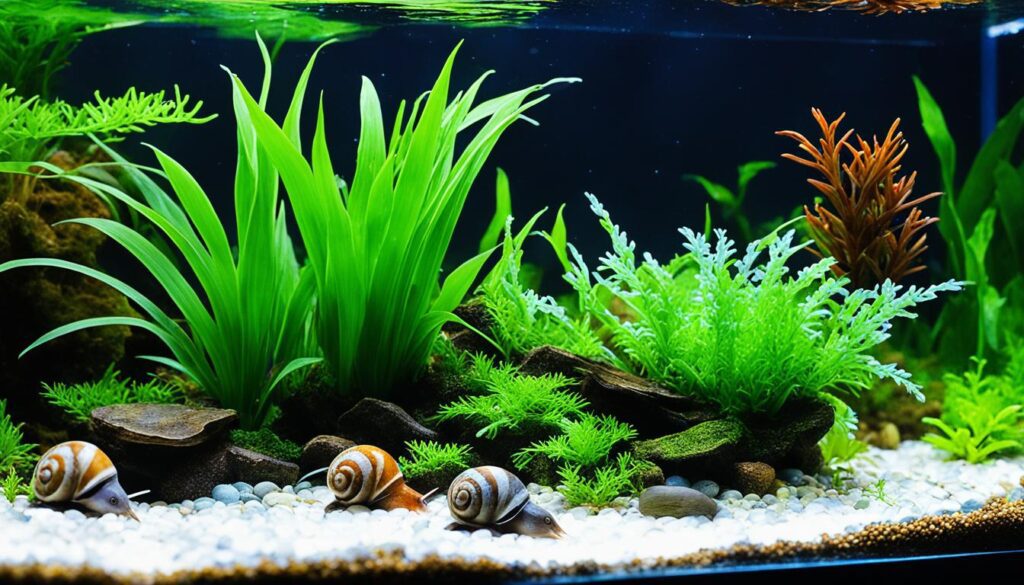
Setting up the perfect tank for your Rabbit Snails is key for their health and long life. We’ll cover everything from the right tank size, to the best substrate, and the importance of aquatic plants. Making their home similar to their natural habitat improves their quality of life and supports their growth.
Choosing the Right Tank Size and Conditions
A 20-gallon tank size is best for Rabbit Snails. This size gives them room to grow up to 3 inches and act naturally. Keep the water temperature between 70°F and 84°F. For breeding, warmer temperatures near 84°F are better. A comprehensive breeding guide has more on this topic.
Decorations: Mimicking Natural Environments
The decor of a tank setup should echo a Rabbit Snail’s natural home. Using driftwood, rocks, and aquatic plants like Java ferns and Anubias not only looks good but is practical too. These features keep the water clean and give snails places to look for food and explore, just like in the wild.
Substrate Requirements for Comfortable Burrowing
The right substrate is crucial for Rabbit Snails’ wellbeing. They love to burrow, and a soft, sandy substrate protects them from harm. Combine black regular sand with black aragonite sand for ideal water hardness. This mix will keep the water between 2 to 15 dKH hardness and a pH of 7.2 to 8.5.
Tank Requirement |
Details |
|---|---|
Lighting |
Hygger 30″ LED light suitable for plants |
Filtration |
Aquarium Co-op sponge filter and AquaClear 50 |
Heating |
100w adjustable heater to maintain optimal temperatures |
Plants |
Java Ferns, Anubias, Vals, Rotala, Bacopa, Moss |
In conclusion, setting up the perfect tank setup for Rabbit Snails is both artistic and scientific. It’s about knowing and recreating their natural needs in an aquarium. This effort keeps your Rabbit Snails healthy and happy and gives you a peaceful underwater scenery to enjoy.
Water Parameters and Health
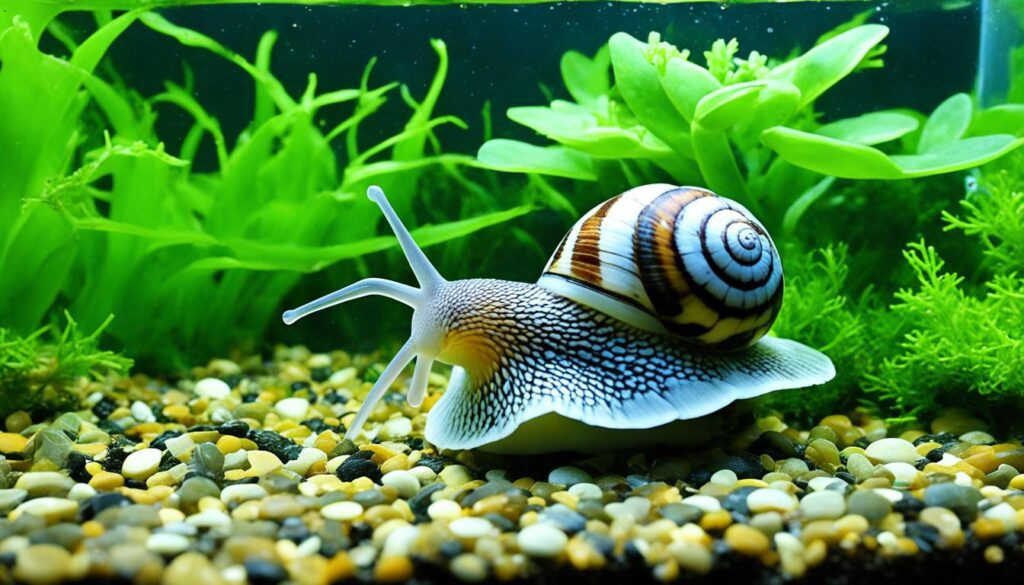
Maintaining optimal water parameters is about more than clean water. It involves copying natural conditions for Rabbit Snails’ health and long life. We will look at temperature, pH, and hardness. These factors are crucial for shell health and their overall well-being.
Optimal Temperature and pH Level for Rabbit Snails
Rabbit Snails do best in 70-80°F. This keeps their body processes running well, like digestion and moving around. Keeping the pH level between 7.5 and 8.4 is also key. It ensures the water is just right, not too acidic or too basic.
Hardness and Alkalinity: Key to Shell Health
The water hardness should be around 3-10 dGH. This level helps with shell health by giving them needed calcium for their shells. The carbonate hardness (kH) should be 2-15. Such levels help keep the pH stable and stop big shifts that stress the snails.
Regular Water Testing: A Critical Habit for Snail Caretakers
Water testing regularly is very important. You can get kits to check pH, ammonia, nitrites, and nitrates. These kits help spot bad changes in your tank quickly. Keeping these levels safe stops snail health problems due to bad water.
In my work, using things like crushed coral in filters helps a lot. It keeps the water hardness and pH at good levels. This is great for tanks where elements might make the water too soft.
Feeding Your Rabbit Snail
Rabbit Snails are detritivores that help keep the aquarium clean. They break down dead stuff, which helps balance the ecosystem and stops too much algae from growing. They are key algae eaters. But, they still need supplemental feeding to stay healthy and get all their nutrients.
Feed Rabbit Snails a mix of things to keep their diet varied like in the wild. Give them algae wafers for plant nutrition and sinking pellets or fish flakes for other important nutrients. Treat them with blanched veggies like zucchini and spinach sometimes. These treats are good for them and make feeding time fun.
- Algae Wafers: Tailored to meet the dietary needs of algae eaters.
- Sinking Pellets: Ensures they receive protein and other vital nutrients.
- Fish Flakes: Easy to consume and packed with variety.
- Blanched Vegetables: Mimics natural vegetation and provides essential fibers.
Plan your Rabbit Snail’s meals with a feeding chart. It helps balance their diet with what your aquarium needs. Here’s a simple guide:
Food Type |
Frequency |
Benefits |
|---|---|---|
Algae Wafers |
2-3 times per week |
High in essential nutrients, helps control tank algae. |
Sinking Pellets |
3 times per week |
Provides balanced nutritional intake. |
Fish Flakes |
2 times per week |
Diverse nutrients that supplement basic algae diet. |
Blanched Vegetables |
Once a week |
Encourages natural foraging and provides fibers. |
In summary, Rabbit Snails do a great job cleaning tanks, but they need more than just algae to thrive. A well-rounded diet is key. It keeps them healthy, helps them grow, and makes your aquarium a better place.
The Social Life of Rabbit Snails
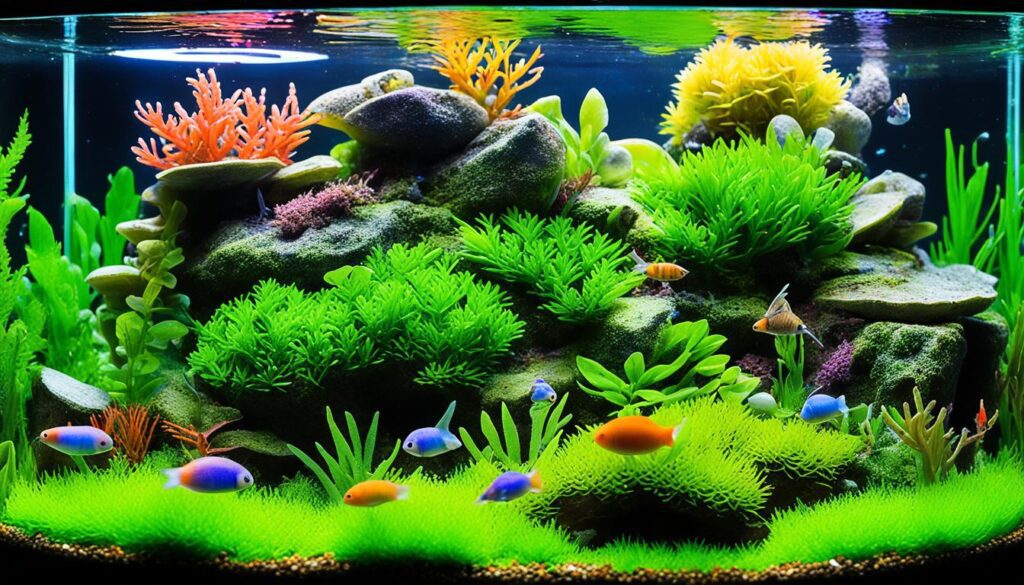
Exploring the social dynamics in an aquarium is as fascinating as a great book. Watching rabbit snail behavior, it’s clear they fit perfectly in any community tank. Let’s look into their interactions and the impact they have underwater.
Rabbit Snail Behavior and Temperament
Rabbit snails are known for being calm. They move slowly through their tank, hiding when scared. They are not aggressive over food, making them good neighbors in a community tank. They adjust well to different environments, if there’s enough to eat.
Compatible Tank Mates
Finding the right tank mates is key to harmony in a community tank. Rabbit snails do well with peaceful fish like Corydoras, Otocinclus, Tetras, and Guppies. Avoid predatory species like Loaches and Pufferfish to keep them from stress. Here’s a list of friends and foes for them:
Good Tank Mates |
Poor Tank Mates |
|---|---|
Guppies |
Loaches |
Platies |
Pufferfish |
Corydoras |
|
Otocinclus |
Crabs |
Non-aggressive Shrimp |
Crayfish |
Signs of Social Stress in Rabbit Snails
Rabbit snails are usually tough. Yet, social stress signs may appear, often from bad tank mates or poor water. Symptoms include less movement and staying hidden. Watching them and keeping the water right (pH between 7.4 and 8.4, temperature from 76 to 84°F) is important for their health.
Rabbit Snail Breeding and Reproduction
I love learning about Yellow Spotted Rabbit Snails from Sulawesi, Indonesia. Their breeding cycle is different from other snails that fill up tanks fast. Rabbit Snails grow to about 4 cm. They need both male and female to breed. They lay a small egg sack every 4 to 6 weeks, with each one giving one to three baby snails.
For those wanting to breed Rabbit Snails, make sure the water is just right. The temperature should be 77-86°F and pH level between 7.5-8.5. You might need to adjust the water to get a GH of 6-15 dGH and a KH of 2-10 dKH. Baby snails need little care right after they are born. They come out ready to explore, with patterned shells, eating soft algae and foods like spirulina and vegetables.
Rabbit Snails can grow up to 3-6 inches and usually live for 2-3 years. If everything in their tank is perfect, they might live even longer. They like being with other peaceful tank mates like small fish and shrimp. But, keep them away from assassin snails that can harm them. Giving them plenty of calcium is good for their shell and makes them look great in the tank.
